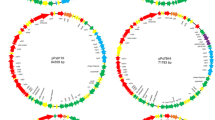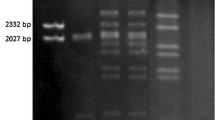Summary
Plasmids isolated from five strains of the bean pathogen Pseudomonas syringae pv. phaseolicola were characterized by restriction endonuclease and filter hybridization analyses. BamHI and EcoRI restriction patterns revealed that total plasmid DNA from each strain had a high level of sequence homology with pMC7105, a 148 kbp integrative plasmid found in a sixth strain. Only six BamHI fragments from the eight plasmids in these strains failed to hybridize with pMC7105 probe. Four of these fragments, three from pPP6520 and one from pPP6525 of strain PP652, hybridized strongly to plasmid DNA from a closely-related pathovar, P. syringae pv. glycinea. BamHI fragment 8, which is involved in the integration of pMC7105 into the host chromosome, contains a repeat sequence that was present on all the plasmids except pPP6120 (6.8 kbp), pPP6310 (40 kbp) and pPP6520 (45 kbp). Every plasmid but pPP6520 had fragments that showed weak hybridization to the small plasmid, pPP6120. This homology suggests that a second repetitive sequence is common to these plasmids. The large plasmids (148 to 151 kbp) were essentially identical to pMC7105. The intermediate plasmids (122 to 128 kbp) appeared to be derived mainly from pMC7105 or a related plasmid, whereas the smaller plasmids (6.8 to 45 kbp) appear to have been derived in part from sequences not present in pMC7105.
Similar content being viewed by others
References
Alwine JC, Kemp DJ, Parker BA, Reiser J, Renart J, Stark GR, Wahl GM (1979) Detection of specific RNAs or specific fragments of DNA by fractionation in gels and transfer to diazobenzyloxymethyl paper. In: Wu R (ed) Methods in enzymology, vol 68. Academic Press, New York, p 220–242
Chakrabarty AM, Friello DA, Bopp LH (1978) Transposition of plasmid DNA segments specifying hydrocarbon degradation and their expression in various microorganisms. Proc Natl Acad Sci USA 75:3109–3112
Comai L, Kosuge T (1980) Involvement of plasmid deoxyribonucleic acid in indoleacetic acid synthesis in Pseudomonas savastanoi. J Bacteriol 143:950–957
Curiale MS (1980) Physical properties and genetic studies of cryptic plasmids discovered in plant pathogenic pseudomonads. Ph.D. Thesis. Oregon State University, Corvallis, Oregon
Curiale MS, Mills D (1977) Detection and characterization of plasmids in Pseudomonas glycinea. J Bacteriol 131:224–228
Curiale MS, Mills D (1982) Integration and partial excision of a cryptic plasmid in Pseudomonas syringae pv. phaseolicola. J Bacteriol 152:797–802
Currier TC, Nester EW (1976) Isolation of covalently closed circular DNA of high molecular weight from bacteria. Anal Biochem 76:431–441
Davis RW, Botstein D, Roth JR (1980) In: Advanced bacterial genetics. Cold Spring Harbor Laboratory, Cold Spring Harbor, New York, 254 p
Gantotti BV, Patil SS, Mandel M (1979) Apparent involvement of a plasmid in phaseotoxin production by Pseudomonas phaseolicola. Appl Environ Microbiol 37:511–516
Gonzalez CF, Vidaver AK (1979) Analysis of plasmids of syringomycin producing strains of Pseudomonas syringae. In: Proc 4th Int Conf Phytopath Bact. Angers. France, p 31–38
Gonzalez CF, Vidaver AK (1980) Restriction enzyme analysis of plasmids from syringomycin-producing strains of Pseudomonas syringae. Phytopath 70:223–225
Jamieson AF, Bieleski RL, Mitchell RE (1981) Plasmids and phaseolotoxin production in Pseudomonas syringae pv. phaseolicola. J Gen Microbiol 122:161–165
McDonell MW, Simon MN, Studier FW (1977) Analysis of restriction fragments of T7 DNA and determination of molecular weights by electrophoresis in neutral and alkaline gels. J Mol Biol 110:119–146
Piwowarski JM, Shaw PD (1982) Characterization of plasmids from plant pathogenic pseudomonads. Plasmid 7:85–94
Poplawsky AR, Szabo LJ, Mills D (1982) Isolation of the plasmid-origin of replication in a plant pathogenic pseudomonad. Phytopath 72:934
Quant R, Mills D (1981) DNA homologies among plasmids of Pseudomonas syringae pv. phaseolicola. In: Lozano JC (ed) Proc 5th Int Conf Plant Path Bact, CIAT, Cali, Colombia, p 412–419
Stanisich VA, Bennett PM, Richmond MH (1977) Characterization of a translocation unit encoding resistance to mercuric ions that occurs on a nonconjugative plasmid in Pseudomonas aeruginosa. J Bacteriol 129:1227–1233
Szabo LJ, Mills D (1982) Identification of a repetitive sequence involved in plasmid-chromosome recombination in Pseudomonas syringae pv. phaseolicola. In: Conference on genetic engineering of plants, p 3
Szabo LJ, Volpe J, Mills D (1981) Identification of F′-like plasmids of Pseudomonas syringae pv. phaseolicola. In: Lozano JC (ed) Proc 5th Int Conf Plant Path Bact, CIAT, Cali, Colombia, p 403–411
White FF, Nester EW (1980) Hairy root: plasmid encodes virulence traits in Agrobacterium rhizogenes. J Bacteriol 141:1134–1141
Author information
Authors and Affiliations
Additional information
Communicated by G.A. O'Donovan
Rights and permissions
About this article
Cite this article
Quant, R.L., Mills, D. An integrative plasmid and multiple-sized plasmids of Pseudomonas syringae pv. phaseolicola have extensive homology. Molec. Gen. Genet. 193, 459–466 (1984). https://doi.org/10.1007/BF00382084
Received:
Issue Date:
DOI: https://doi.org/10.1007/BF00382084




